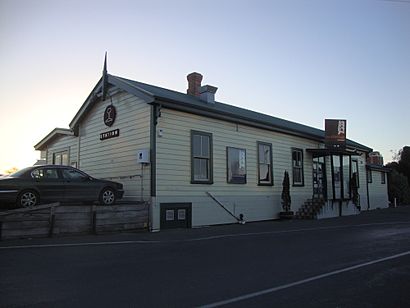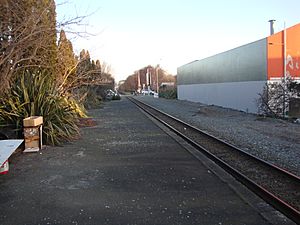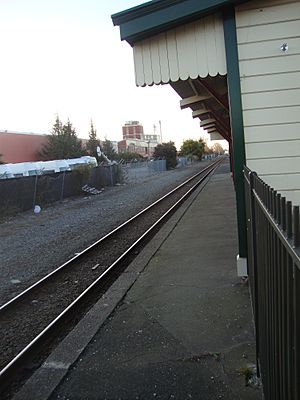Papanui railway station facts for kids
Papanui railway station was a train station in the Papanui area of northern Christchurch, New Zealand. It was part of the Main North Line. The station was located about 5.3 kilometers (3.3 miles) north of Addington Junction.
Papanui station handled both goods and passenger trains. It opened in 1872 and closed in the late 20th century. From 1880 to the 1930s, it was also a place where people could switch between trains and trams. The old station building is still there today and is used as a restaurant. There have been ideas to bring back train services to Papanui, but none have been approved yet.
Contents
Station History
How the Station Worked
The Beginning (1872-1880)
The government decided to build the Main North Line in 1870. On April 29, 1872, the train line officially opened to Kaiapoi. A special train stopped at Papanui station, where important people gave speeches.
Regular train services started on November 5, 1872, when the line reached Rangiora. At first, there were three "mixed trains" daily. These trains carried both passengers and goods. By 1876, when the line extended to Amberley, there were two passenger trains and one mixed train each day. Later, night trains also began running.
The train line from Christchurch to Amberley was first built with a wider track, called a "broad gauge" (5 feet 3 inches). This was very expensive. So, in 1877, they decided to change it to the national standard, a "narrow gauge" (3 feet 6 inches). This change happened on December 20, 1877. The line closed temporarily for a few days while workers changed the tracks. Buses replaced the trains for passengers and mail. The line reopened the next morning.
Trains and Trams (1880-1934)
In 1880, the Canterbury Tramway Company opened a tram line to Papanui. This line had a short track that went right behind the Papanui railway station. The company also built a shed there for trams. This meant people could travel by tram between the Papanui railway station and the Christchurch railway station in the city center.
Trams were pulled by steam engines at first. But in 1893, the tram company ran into money problems. Another company, the Christchurch Tramway Company, took over. They started using horses to pull the trams instead of steam engines.
Later, the Christchurch Tramway Board took over the Papanui tram line. They updated it for electric trams. Electric tram services started in Christchurch on June 5, 1905. The tram company had a special agreement to use land at the Papanui railway station. When the Tramway Board took over, the Railways Department did not want to transfer this agreement. They finally reached a deal in 1906, allowing the Board to use the land until 1926 for a small yearly fee.
In 1916, the Tramway Board wanted to make the line longer for bigger trams. This caused another disagreement. It was solved when the land the Board used at the station entrance became part of a public road.
When the agreement needed renewing in 1926, the Railways Department offered to extend it indefinitely. The Board accepted. However, by 1930, fewer and fewer people were using the tram service to the railway station. It was no longer making enough money. During the Great Depression, the Board looked for ways to save money. They thought about stopping the tram connection to Papanui railway station.
In 1932, they checked how many passengers used the service. Only about 96 passengers used 76 trips to the station each week. The Board decided to end services at Papanui Township instead of going all the way to the station. The Railways Department was worried about this. So, they stopped charging the yearly fee to keep the service going. But even with no fee, almost no one used the railway station tram service anymore. So, on April 16, 1934, the tram timetable removed the railway station extension.
The tram tracks stayed in place until the line closed in 1954. They were sometimes used to store empty trams. After the tram tracks were removed, the area became known as Station Road. The Christchurch City Council paved it, and it became a public road.
Busy Times (1880-1956)
As more people moved to Christchurch and nearby towns, more trains ran through Papanui. By 1916, there were two passenger trains and three mixed trains each day. These trains traveled between Christchurch and Rangiora. By 1927, this had increased to five passenger trains and one mixed train daily. An extra battery-electric railcar service ran at midday. The 1943 timetable showed four southbound and five northbound passenger trains every weekday. An extra early-morning southbound train was added in 1949.
These passenger trains were for people traveling short distances, like commuters. They were not as frequent as trains on the Lyttelton Line. But they were popular for people traveling to Christchurch from smaller towns. They were also cheaper than the bus services available. At their busiest, Papanui station saw 10 to 12 passenger or mixed trains every day.
Changes and Decline (1956-1991)
The number of passenger trains started to drop in 1956. There were only three daily return trips. One of these was run by two connected railcars. On March 27, 1957, the midday train was canceled. Ten years later, on July 3, 1967, regular trains pulled by locomotives replaced the railcars. At this time, the number of services dropped even more, to just one return train per day.
New diesel-electric engines replaced the old steam engines. But this was not enough to stop the decline in passenger numbers. The passenger service officially ended on April 30, 1976. By then, the trains often had very few passengers. After this, the only passenger trains that regularly passed through Papanui were the long-distance trains to Picton. These trains were sometimes called the Picton Express. Later, they were known as the Coastal Pacific and the TranzCoastal from 1988. These long-distance trains did stop at Papanui.
Papanui stopped accepting general goods on October 13, 1986. After that, it was only used as a "Special Purpose Freight Terminal." This meant it handled goods for specific private companies that had their own train tracks, called "sidings." At that time, the station handled coal and tires. Companies like Thomas Brown (a coal merchant), Sanitarium Health Foods, and Firestone Tire and Rubber used these sidings. However, Sanitarium's siding was planned to close soon.
Station's End
After closing in 1991, the station building was empty for several years. In late 1993, the Christchurch City Council decided to buy the station building. This was part of a deal to get land to extend Restell Street. Any extra railway land at Papanui was given to the Department of Survey and Land Information on January 1, 1994, to be sold off.
After buying the property in 1994, the Council decided not to move or knock down the building. After some difficulty, they found a business to rent it.
Station Facilities
Goods Shed
In February 1984, a fire, possibly caused by arson, damaged the goods shed. It would have cost more to fix the shed than it was worth. Since Firestone was the only company still using it, they decided to demolish it instead. The rest of the shed was sold for removal on June 13, 1984, and the work was finished in August.
Loading Bank and Stockyard
There was a loading bank behind the goods shed. This was used for loading and unloading goods. Papanui never had special yards for livestock like cattle. It was thought that not enough animals were transported through Papanui to make building these yards worthwhile. Other facilities were available at Addington and Chaneys.
Private Sidings
Several companies near Papanui station had their own private train tracks, called sidings. These tracks connected their businesses directly to the main railway line.
- Firestone Tyre Company: Used a siding from 1948.
- Sanitarium Health Food Company: Used a siding from 1923 until about 1986.
- Borgfeldt's: Used a siding from 1882 to 1916. Later, Frank Drury & Sons (a blacksmith) used it from 1916 to 1972. Then Thomas Brown (a coal merchant) used it from 1972. This siding was no longer used by 1980.
The Sanitarium factory is still open today. The Firestone factory closed in 2009.
Station Building and Platform
The first station had a wooden platform and a simple building. It was considered good enough for the amount of business it handled. In 1899, people asked for improvements to the station. The building was called "not modern." Even though many passengers used the station, most arrived by tram. So, a new building was not thought necessary at the time. However, a new station building with a veranda was approved and built the next year, in 1900. The Post Office, which had been operating from the station, moved to its own building.
In 1903, they approved making the platform longer, from 200 feet to 500 feet. To do this, the tram company's agreement to enter the station yard had to end. The Railways Department gave notice in 1904 to cancel the tram company's agreement.
The platform was made shorter in 1977, down to 135 meters (443 feet).
On February 20, 1998, the New Zealand Historic Places Trust (now Heritage New Zealand) officially recognized the station building as an important historical structure. It was given registration number 7415. The building was designed by New Zealand Railways. It is a good example of a "Troup Type C" station building, or an early version of a "Troup Period B & C Type" station. George Troup was the Head Draftsman at the time.
Future Ideas
Double Tracking
In the 1940s, there was an idea to add a second track to the Main North Line between Addington and Rangiora. This would help with train traffic jams. If the line had two tracks, the Railways Department planned for an "island platform" at Papanui. This type of platform allows trains from both directions to stop at the station. Even without a second track, an island platform at Papanui was thought to be useful for trains to pass each other.
Money was set aside in the budget from 1943 to 1947 to build an island platform and a new station building. The old building was not suitable for an island platform. However, the Railways Department eventually decided not to build the second track or the island platform.
Christchurch Commuter Train Revival
Since the Christchurch–Rangiora passenger train service stopped in 1976, there have been several reports about bringing back passenger trains to Christchurch. Two recent reports are the Proposed Introduction of Commuter Rail Services to Christchurch City and Environs (2005) and the Greater Christchurch Northern Rail – Rapid Assessment (2014).
Commuter Rail Services Report (2005)
Environment Canterbury asked for a report in 2005 about new passenger train services for Christchurch. The report looked at services to Lyttelton, Rolleston, and Rangiora. It said that more detailed studies would be needed to decide where new stations should be. Some of the ideas in the report would have meant adding a second track and new signals through Papanui.
Northern Rail Rapid Assessment (2014)
After the 2010 and 2011 earthquakes, traffic became very bad for people driving into Christchurch from the Waimakariri District. Environment Canterbury asked for a quick study called the Greater Christchurch Northern Rail – Rapid Assessment. This study looked at a temporary passenger train service between Rangiora and Christchurch. It aimed to see if existing train facilities could be used cheaply to run a peak-time service. This would help reduce road traffic until road improvements were made.
The report concluded that the best option would be a service from Rangiora to Addington. It would stop at Kaiapoi and Papanui, with connecting bus services. However, for a temporary service, it was too risky and could not be justified.
The report mentioned that Papanui station's platform could be resurfaced for about $22,725 to be suitable for passenger trains. It also noted that trains stopping at Papanui would set off the alarms at the Harewood Road or Langdons Road level crossings for the entire time the train was stopped.
The Government agreed with the report's findings and decided not to go ahead with the project.
Today
The only important railway parts left at the site are the station building and its platform. Since the station closed, different businesses have rented the building. Most recently, a restaurant is operating there.
There is also a railway carriage on display at the north end of the station platform. It is on loan from the Canterbury Railway Society.
Images for kids





